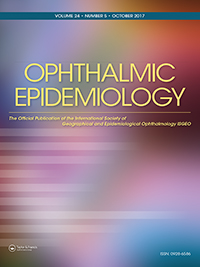A population-based study of corneal arcus and its risk factors in Iran
Authors
Affiliations
Abstract
Purpose: To determine the prevalence of corneal arcus, its risk factors, and its relationship to ocular and visual indices.
Methods: In this cross-sectional study, 300 clusters were randomly selected from Shahroud in the north of Iran, using multistage sampling. A total of 20 people were invited to participate from each cluster. After enrollment, all optometric, biometric and ophthalmic exams were conducted on site.
Results: Of 6311 people invited, 5190 (82.2%) participated in the study. The prevalence of corneal arcus was 23.3% (95% confidence interval, CI, 22.1-24.6), and 98.4% were bilateral cases. The prevalence of corneal arcus was higher in men (odds ratio, OR, 2.02, 95% CI 1.8-2.3, p < 0.001) and increased with age (OR 1.1/year, p < 0.001). In a multivariable-adjusted regression model, age (OR 1.1/year, p = 0.006), male sex (OR 1.30, p = 0.001), diabetes (OR 0.7, p < 0.001), smoking (OR 1.5, p = 0.003), outdoor activity (OR 1.4, p = 0.006), systolic blood pressure (OR 1.01, p = 0.012), and diastolic blood pressure (OR 0.99, p = 0.016) were significantly correlated with corneal arcus. Including biometric components in another model, corneal thickness (OR 0.99, p < 0.001), anterior chamber depth (OR 0.68, p < 0.001) and corneal radius of curvature (OR 1.59, p < 0.001) were significantly correlated with corneal arcus. Conclusion: This study adds valuable information to the epidemiology of corneal arcus in Iran and the Middle East. In people aged over 60 years, nearly 50% of the study population had corneal arcus. Older age, male sex, smoking, and systolic hypertension were risk factors for corneal arcus. Corneal arcus was also associated with thin and flat corneas and shallow anterior chamber depth.
Keywords: Corneal arcus; Iran; Middle East; cross-sectional study; prevalence; risk factors.

